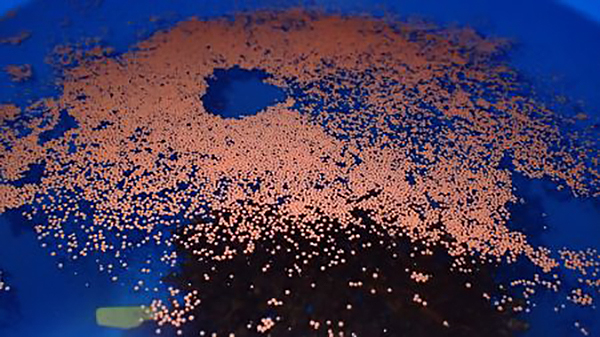Stray light from coastal development can severely disrupt coral reproductive cycles, new study finds—and blue-spectrum LED lighting is the worst.

2020-11-08
via Bar-Ilan University
Artificial light produced by powerful street lamps, billboards, sports and industrial facilities, hotels, and office buildings effectively extends the day for work and leisure activities. But while artificial light at night (ALAN) is one of the most important human technological advances, the alteration of natural light cycles has many undesirable effects on the earth’s ecosystems. These include skyglow, light trespass, glare, and over-illumination, collectively referred to as light pollution.
Due to the high rate of urban development in marine coastal areas around the world, light pollution could further threaten coral communities’ populations, which are already under severe degradation. A new study led by researchers from Isreal’s Bar-Ilan University demonstrates how light pollution is negatively impacting the reproductive cycle of two coral species.
With a global transition towards LED lighting and rapid population growth in coastal regions, researchers say the harmful effects of artificial light must be considered in order to preserve coral reefs already endangered by a variety of additional threats
The daily light-dark cycle arising from the earth’s rotation is centrally important to biology. Marine organisms, particularly coral reefs, rely on natural light cycles of sunlight and moonlight to regulate various physiological, biological and behavioral processes.

The coral reproductive cycle (the development of sperm and eggs) is controlled by a biological rhythm a few months during the year in harmony with natural environmental conditions. At the conclusion gametes (sperm and eggs) are released into the water for external fertilization. The mechanism that leads to synchronized spawning is thought to be controlled by both an exogenous (i.e., environmental) and endogenous apparatus (i.e., biological clock). Successful gamete production and fertilization, development of viable offspring, and survival of new coral recruits are possibly the most important processes for replenishing degraded reefs. Moreover, sexual reproduction maintains coral populations and supports evolutionary processes which may enhance fitness.
For this study, just published in the journal Current Biology, researchers collected and tracked two coral species, Acropora millepora and Acropora digitifera, from the Indo-Pacific Ocean. Ninety colonies were transferred to the Bolinao Marine Laboratory, located in an area in the Philippines with no light pollution. The colonies were placed in outdoor tanks, exposed to natural sunlight, moonlight, and seawater. Solar exposure was adjusted to equivalent levels experienced by corals at their collection depth of five meters. Coral colonies were divided into three groups: two experimental and one control. Each group was composed of 15 colonies from each Acropora species divided randomly into three tanks. The experimental groups were treated with LED lamps possessing both cold (white with more blue light) and warm (yellowish with less blue light) spectra.
For three months the LED lamps were activated every day from sundown until sunrise. The control groups were exposed to the same conditions as the experimental colonies (natural solar light, moonlight phases) but without supplemental light at night. Chlorophyll fluorescence yield was assessed on a monthly basis as an indicator of colony health.
The results clearly showed that light pollution caused delayed gametogenesis and unsynchronized gamete release, emphasizing the importance of natural periodic illumination, both solar and lunar, as a critical factor in cueing spawning synchronicity and the gametogenic process.
“Both key coral species were affected by ecological light pollution. They exhibited asynchrony in the reproductive state which was reflected in the number of oocytes per polyp, gametogenesis, and gamete maturation,” says the study’s lead author Prof. Oren Levy, of the Mina and Everard Goodman Faculty of Life Sciences at Bar-Ilan University. “This was further reflected at the population level where only corals exposed to natural light cycles succeeded in spawning synchronization. Light treatment with both cold and warm LED’s had a similar impact on the gametogenesis cycle,” added Levy.
Levy led the Bar-Ilan study with the participation of the Interuniversity Institute for Marine Sciences in Eilat and Tel Aviv University team members Inbal Ayalon and Dr. Yaeli Rosenberg, and in collaboration with team leader Patrick Cabaitan, from The Marine Science Institute at the University of the Philippines, and light pollution specialists Dr. Christopher Kyba and Dr. Helga Kuechly from the German Research Centre for Geosciences GFZ.
To shed light on how relevant their findings are on a worldwide scale, the researchers created a first-of-its-kind global map that highlights areas most threatened by ALAN including the Caribbean Sea and the Pacific and Indian Oceans. One striking example is the Gulf of Aqaba/Eilat in the northern Red Sea, where considerable urban lighting is present close to shore. Here, the least affected area is 47% brighter than a natural night sky, and this rises to a maximum of 60 times brighter.
With the global transition towards LED lighting, which tends to have higher emissions in the blue spectrum, more near shore coral reefs could be affected by artificial light, as blue light penetrates deeper into the water. This spectral shift is expected to be amplified by the current rapid population growth in coastal regions. Levy and team’s results demonstrate that artificial light must be considered in conservation plans for coral reefs near areas of human activity and their light pollution impact assessment can help incorporate an important variable in coral reef conservation planning.
In follow-up research Levy hopes to determine whether there are corals more adapted to light pollution and, if so, what mechanism underlies their resilience.
From materials released by Bar-Ilan University
Reference
Inbal Ayalon, Yaeli Rosenberg, Jennifer I.C. Benichou, Celine Luisa D. Campos, Sherry Lyn G. Sayco, Michael Angelou L. Nada, Jake Ivan P. Baquiran, Charlon A. Ligson, Dror Avisar, Cecilia Conaco, Helga U. Kuechly, Christopher C.M. Kyba, Patrick C. Cabaitan, Oren Levy. Coral Gametogenesis Collapse under Artificial Light Pollution. Current Biology, 2020; DOI: 10.1016/j.cub.2020.10.039
Summary
Here, we demonstrate that light pollution caused delayed gametogenesis and unsynchronized gamete release in two coral species, Acropora millepora and Acropora digitifera, from the Indo-Pacific Ocean. Given the urbanization along major coasts, light pollution could thus further threaten coral communities’ populations, which are already under severe degradation. A worldwide-modeled light pollution impact assessment is provided, which can help incorporate an important variable in coral reef conservation planning.




